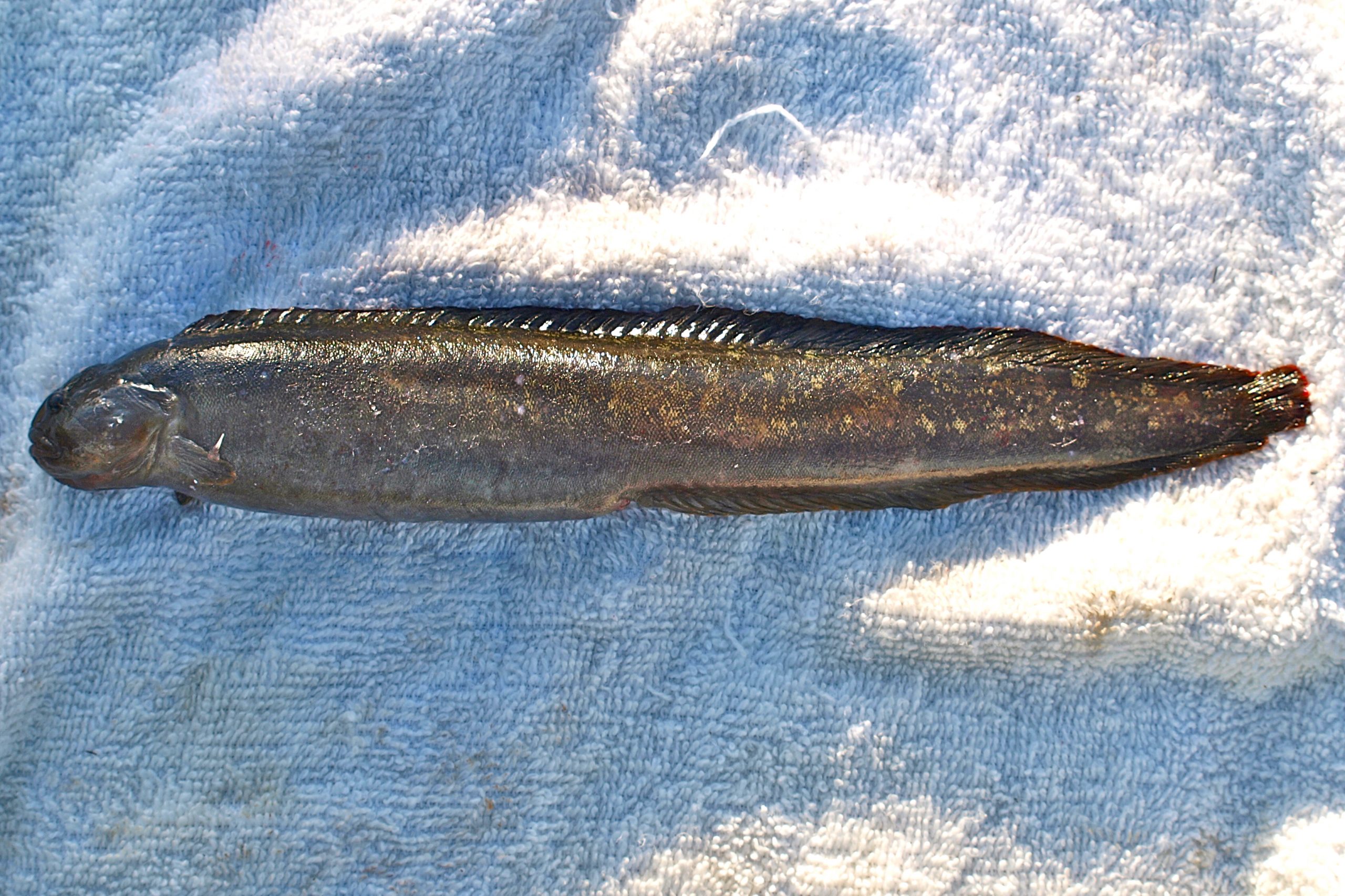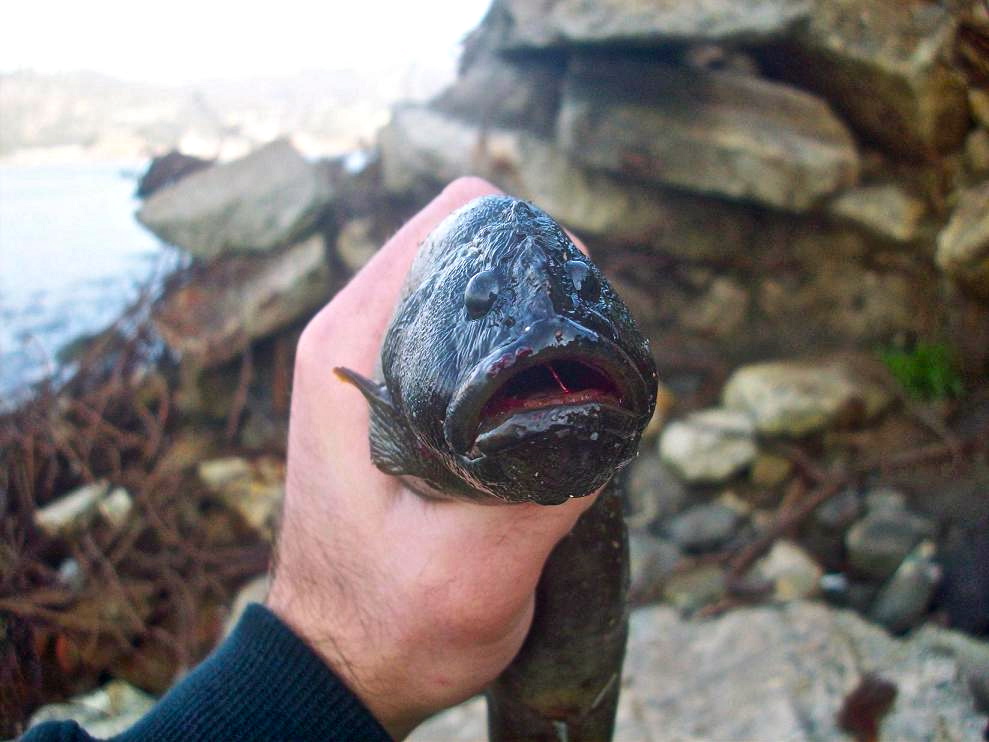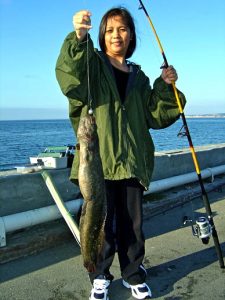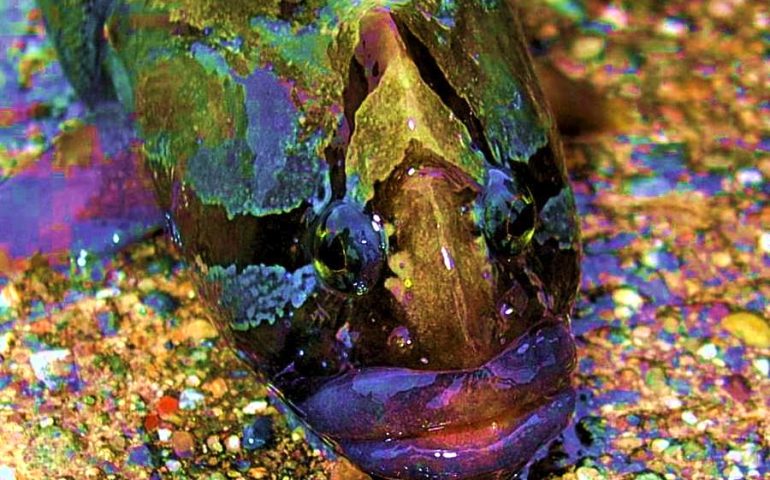Pricklebacks: Family Stichaeidae
Species: Cebidichthys violaceus (Girard, 1854); from the Greek cebidichthys (two words meaning Sapajou—a kind of monkey, and fish); and the Latin word violaceus (meaning violet).
Alternate Names: Monkeyface eel, blenny eel, monkeyface blenny. Called abrojo cara de mono in Mexico.
Identification: Typical eel shape. Adult fish have a lumpy ridge on the top of the head. Dorsal fin is about half spines and half soft rays. Uniform dull black, olive or gray with 2 darker bars radiating downward from the eye. Some fish have been noted with orange spots on the body or orange at the edge of the fins.

Size: Length to 30 inches. Most caught from piers are 12-24 inches long. The California record was a 7 Lbs 8 oz fish taken at Pescadero, San Mateo Co. in 2019. The diving record fish weighed 7 Lbs 5 oz and was taken at Carmel in 2013. The IGFA World Record fish is listed at 3 Lbs 4 oz for a fish caught in Yaquina Bay, Newport, Oregon in 2008.
Range: Bahia San Quintin Bay, northern Baja California, to Netarts-Cape Mears, north Oregon. Common eastern-most Channel Islands, southern California, to northern California. Rarely seen south of Point Conception.

A monkeyface eel (prickleback) caught by “Turtle”
Habitat: Intertidal to 80 feet deep; common in shallow rocky areas.
Piers: Generally found at piers in rocky areas or where debris has accumulated at the base of the pier. Best bets: Monterey Coast Guard Pier (the best), Princeton Harbor Pier, Fort Point Pier, San Francisco Municipal Pier, Angel Island Pier and Elephant Rock Pier.

Shoreline: A favorite species for anglers fishing rocky areas and jettys from Point Conception to San Francisco (especially poke polers). Favored areas include Shell Beach (near Pismo Beach), rocks and jetties near the Golden Gate, rocks between Stinson Beach and Muir Beach, rocks between Bodega Bay and Dillon Beach, and rocks north of Crescent City.
Boats: An inshore species rarely take from boats.
Bait and Tackle: Medium tackle; size 4-2 hooks; cut bait (squid), shrimp, pile worms or fresh mussels. The eel’s most common food is crustaceans and algae.
Food Value: Excellent eating. Mild flavored, white colored flesh with no apparent flakes and a very firm texture. The flesh has low fat content and can be cooked many ways but poaching and steaming are favorites.
Comments: Very hard to catch from a pier. Will strike bait and then immediately head back to its rocky lair. Anglers must strike quickly and then keep the pressure on the fish to force it away from the rocks. More commonly caught by “poke poling” in rocky areas along the shoreline.

The picture above is of a Wolf Eel. (also a fish, not really an eel)
No, it’s a monkeyface eel aka monkeyface prickleback, a large monkeyface eel. It is not a wolf eel.
I concur with Ken, all of those photos are of Cebidichthys violaceus (the Monkeyface Prickleback), not a Wolf eel. None of them are actually “eels” (anguilliforms), and monkeyface eels are related to wolf eels, seeing they are in the same suborder (Zoarcoidei). The give away here, in addition to head shape and markings, are the pectoral fins (way too small for a wolf eel).
I want to catch one in southern california! Where can ok catch one?
They would be a really rare catch at any of the SoCal piers.
Does anyone know where can I poke pole monkeyface eel in the East Bay? Somewhere near Hayward?
It would be rare to catch one in the south bay or east bay.
no bag limit on monkeyface
I catch 25 monkey face eels at the Half Moon Bay pier
it was fun
Any body poke poled inshore around dumbarton? wonder if any eels hanging around there.
I got two yesterday with rod and reel. Lost one to coming off look. Then lost two by eel going under the rocks. Trick is to release pull on the line, move direction of pull, then pull again. Eel will move to get another “better” hiding place and be exposed. It ulls hard for a bit and then gives up.